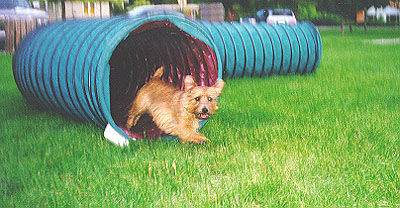
Clipper sails through the tunnel. What's next?
Articles Index/Agility
Posted 07/02/00
Although living near Boise, Idaho, means we have to travel a considerable distance to get to dog shows, I am very fortunate in that there are two all breed clubs in the area and a private agility dog club. I started taking Clipper (Surrey Baltimore Clipper) to an agility class in the spring and we have since gone on to an intermediate class. I have been bitten by the "agility bug" . (Beware, because it is very addictive.) I initially wanted to do agility with Clipper to build his confidence for showing. It has done that and more. Clipper has also built stamina and muscle, and most of all he is having fun.
Agility looks like it's so much fun that it you wouldn't think it requires a lot of training, but it does. The dogs start at lower heights and gradually work up to regulation heights. They also require some basic obedience training because the dogs are off leash when competing. They must know come, stay, sit and down, and then you can eventually train them to understand directional commands, such as left and right, go out, and here.
Two obstacles that may take a little more time to train are the teeter-totter and the A-frame. The teeter is an obstacle that can "mess up" a dog if it's not introduced correctly. If the dog just runs up to the teeter without pausing at the balance point, it will get jolted as the teeter hits the ground at the same time the dog is coming off the end of it. Many dogs will lose their enjoyment of agility after such an experience. The correct way to teach the teeter is to bring the dog up slowly with someone holding the end of the teeter to control the downward movement. Once the dog reaches the balance point where the teeter begins to go down, you place a piece of food at that point each time you do the obstacle. Then tell the dog to either "look" or "wait" and let the dog take the food as the teeter is slowly lowered to the ground and the dog is encouraged to continue off. Eventually, the dog will learn to brace itself while the teeter lowers and then run off. Clipper almost has the idea because I can see him lean back as he reaches his balance point and he is responding to my verbal cue to "wait".
The A-frame has been difficult for Clipper because of his short legs and his small size. He had to build up the muscles in his back legs and learn to use the raised slats to push against to get up the A-frame. It also requires a good, strong approach with enough speed to help get up to the top. Coming down the other side is also difficult for Clipper as the A-frame gets higher (he hasn't done the full height yet!). He is very cautious coming down because he starts to slide with the steep angel. He tends to lean back like he does for the teeter and catches himself on the raised slats as he goes down. Larger dogs have it a little easier because of their long legs, but must be careful in running down the A-frame that they don't jump off too soon and miss the contact area. The contact area is a different color and the dog must put at least one paw in that area to complete the obstacle. The teeter, A-frame and dog walk all have contact areas.
There is a lot more to agility than meets the eye, but it is so much fun that, given the right beginning, dogs really enjoy it and get so excited and motivated. It is fun to teach and practice. It is also fun to watch and often gets the most spectators at a show because of the fast paced action and the funny things that dogs or handlers do in their rush to negotiate the course. Norfolks are very well suited to this sport. I noticed how Clipper loved to jump up on things when I first got him low tables in front of windows, people's laps, and any natural obstacle outside. Tunnels are also a part of agility, both open and closed tunnels. This should be a natural for our Norfolks. So, if you have the opportunity and there is an organized club with regulation equipment, try it out. You'll be hooked.

Sandra Healey
ANTIC, December, 1999
Back to Articles Index
Back to Home Page